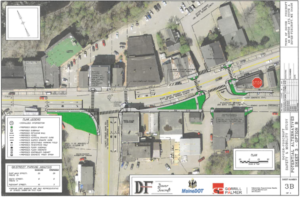
Problematic Dover-Foxcroft intersection will be rebuilt but timing is the question
A problematic intersection of two major state roads in downtown Dover-Foxcroft will be reconfigured to accommodate tractor-trailers. The question may be when.
A traffic study has been done, proposals for changes have been drawn up, the town has weighed in on its preference, the Maine Department of Transportation has purchased an empty building on one corner of the intersection, but construction is unlikely until at least 2023, the soonest funding will be available.

Bangor Daily News photo/Ernie Clark
TIGHT CORNER A pedestrian walk button that normally would be placed on the adjacent post instead is attached to the wall of a vacant office building at the intersection of Route 7 and East Main Street in Dover-Foxcroft because of frequent traffic incidents involving tractor-trailers because of tight quarters at the turn over the years.
“It’s been a problem for me for 20 years, at least,” said MaineDOT state traffic engineer Steve Landry of the intersection — where at least one crosswalk post has been knocked down so often by turning trucks that the signal button pedestrians push to cross the street is attached to a building instead of a nearby post.
Two proposals have been developed for the intersection of state routes 15 and 7, known locally as East Main Street and South Street, as part of an urban traffic study recently completed by the Gorrill Palmer civil engineering firm of South Portland in conjunction with the town and the Maine Department of Transportation.
Both plans would raze a small, vacant office building the MaineDOT recently purchased with the plan preferred by the town — 3B — providing additional space to widen the current lanes for the benefit of both truck and pedestrian traffic. The building is where the crosswalk button is located.

Plan 3B for the intersection of routes 15 and 7 in Dover-Foxcroft includes providing additional space to widen the current lanes for the benefit of both truck and pedestrian traffic.
A second option — 3A — would create a slip lane for vehicles to make a direct right turn onto South Street headed toward Dexter, as well as a pedestrian crossing island within the intersection.
“Obviously it’s great to have a couple of options and to have a preference from the community, and I think we kind of agree that 3B is preferable over 3A,” MaineDOT chief operating officer Bill Pulver said. “3A has a flatter turning radius for the trucks but it creates kind of a pedestrian refuge out in the middle that can be confusing to pedestrians and drivers. Sometimes we’re forced into something like that and it will work, but it’s preferable not to have that.”
Space has been tight at the intersection for decades with buildings crowding both sides of the roads involved.
That has left insufficient space for lanes wide enough to accommodate a steady stream of tractor-trailers as well as other traffic, some of which is not accustomed to the unique location of painted stop bars meant to keep those vehicles far enough back from the street lights to allow the big rigs to turn.
“The stop bar is way back from normal because if you drive all the way up and crowd that light and then you’ve got a truck that’s going south and trying to make that turn, they have to take a wide swing and overshoot their lane into the other lane to make that turn,” Dover-Foxcroft town manager Jack Clukey said.
He said he has seen vehicles back up at the intersection to make room for a truck to turn left.
Clukey said the DOT commissioner witnessed the problem first hand during a visit last summer.
“We were all standing there on the corner for probably less than five minutes and a truck turned the corner too tight and rolled right up on the curbing just a few feet from where we were standing. There was not a better example than when we were standing there as to what the issues are there,” Clukey said.
MaineDOT and the town will collaborate on removing the former Dead River Company building, with the transportation department responsible for preparing the building for demolition — such as removing any hazardous building materials — and the town responsible for removing the structure and regrading the site.
Clukey said the town’s goal is for the building to be removed and the site regraded by late 2020 or early 2021.
MaineDOT will be responsible for site maintenance and has agreed to give the town a license to use the portion of the building site not needed for traffic improvements for parking spaces and benches, Clukey said.
Further design engineering is anticipated to complete the plan.
“We have some concepts and we’ve looked at them, but once we start a preliminary engineering project that’s when we’ll do a more detailed survey,” Pulver said. “It’s likely we’ll start with the 3B concept and then we might have some other suggestions from engineers to tweak that a little bit.”
MaineDOT works on a three-year project cycle, meaning it will be 2023 at the earliest before construction would be funded, Landry said.